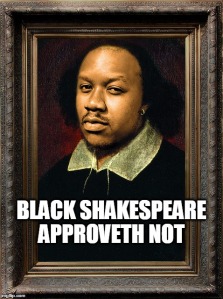In theatre and in academia, my two worlds, we talk a lot about “diversity.” In theatre, we talk about diversity in casting, we talk about diversity in programming, we talk about diversity in audiences. In academia, we talk about “attracting and retaining diverse students” and “the diversity of our faculty.” But there’s a massive elephant in the room that we continue to ignore.
Diversity is not enough.
Do not confuse “diversity” with “equity.” I have been in far too many situations where an organization hires a handful of people of color, plunks them into the lowest rung (either by title or by treatment) and then never thinks about them again. I have been in far too many situations where faculty believe they are “working to retain” students of color by designing classes with titles like “Keepin’ It Real: African American Performance,” taught by a fussy middle-aged musical theatre professor, instead of engaging the students directly to discover what support they actually need. I have been in far too many situations where highly skilled and qualified women are hired and then passed over for promotion in favor of mediocre– or even demonstrably unqualified– men. I have been in far too many situations where a white man who is new to the organization is suddenly and dramatically promoted and given plum assignments in secret, announced to the stunned women who were passed over as a fait accompli.
Diversity fails if it’s not combined with equity.
Too many white male-run orgs frame diversity as bending down to lift up women and people of color. Women dominate the indie theatre scene as artistic leaders. They’re already out there, creating art every day. People of color aren’t just creating art– they’ve created most of popular American culture.
It’s telling when you hear people say things like, “Black children in the inner cities have no access to art,” and “We need to find ways to help people of color access theatre.” When we discuss “art” or “theatre” in these contexts, we mean “white art” and “white theatre.” We mean the work white people have deemed “important.” If there’s one thing inner cities have never lacked, it’s art. Most of popular American culture originated with artists of color in inner cities. Hip hop revolutionized music across the globe. Graffiti became a global school of art. Both hip hop and graffiti are already studied and taught in universities globally alongside other important artistic movements like minimalism and abstract expressionism, both of which, I’d like to point out, were originally held in as much disdain as hip hop and graffiti have been. You don’t bend down to grant art to people of color. They’re not starved for art, waiting for a white savior to show up and grant them access. People of color are lapping white culture artistically.
The problem isn’t a lack of access to “art” for women and people of color. The problem is lack of access to funding and well-paid positions of power. The problem is equity.
If we’re discussing equity, we’re discussing important topics like the glass ceiling– how larger theatres across the nation give almost all the positions of power to white men and show no signs of improving over the years we’ve been discussing this. How universities still give the majority of their tenure track positions to men and the majority of their poverty-level adjunct positions to women, despite that Cornell study that measured hypothetical attitudes. The hard data is clear, and those numbers widen when you add race to the mix.
If we’re discussing equity, we’re discussing how grantors and individual donors give white-run arts orgs far more funding than they do arts orgs run by people of color. We’re discussing how the study I linked above had the audacity to suggest that lower-funded orgs run by people of color should be left to “wither” and close.
If we’re discussing equity, we’re discussing how large, well-funded, white-run theatres are given massive grants to do “community outreach” programs to potential audiences of color when the theatres run by people of color, who are already doing that work, are left to fight for scraps. That’s diversity without equity– funding a wealthy white org’s diversity initiative instead of funding a smaller Black org that’s been doing that work for decades. Funding doesn’t have to be either/or. Where are the grants that fund partnerships or co-productions between those orgs? Or between women-run smaller theatres that attract diverse young audiences and the larger theatres that say they’re desperate for those audiences? I would have brought my theatre company into a larger theatre for a co-production in a heartbeat.
The problem with diversity without equity is that diversity can be accomplished in ways that entirely preserve the white male power structure. We congratulate diversity in programming and we ignore the fact that nearly every LORT AD position in the US from the institution of the 501c3 in 1954 to this very day has gone to a man, almost always a white one. We’re making calls for diversity that amount to asking white men to please hire more women and people of color while we ignore the fact that theatres run by women and people of color are literally starving for funding.
Diversity alone is not enough without actively seeking equity at all levels of our industry. We need to commit to both diversity AND equity.
UPDATE 9/8/16: Please read Jason Tseng’s excellent article about equity in arts funding: “The Kaiser Games.”









































